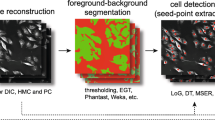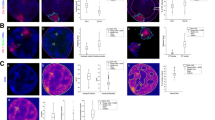Abstract
Automated robotic bio-micromanipulation can improve the throughput and efficiency of single-cell experiments. Adherent cells, such as fibroblasts, include a wide range of mammalian cells and are usually very thin with highly irregular morphologies. Automated micromanipulation of these cells is a beneficial yet challenging task, where the machine vision sub-task is addressed in this article. The necessary but neglected problem of localizing injection sites on the nucleus and the cytoplasm is defined and a novel two-stage model-based algorithm is proposed. In Stage I, the gradient information associated with the nucleic regions is extracted and used in a mathematical morphology clustering framework to roughly localize the nucleus. Next, this preliminary segmentation information is used to estimate an ellipsoidal model for the nucleic region, which is then used as an attention window in a k-means clustering-based iterative search algorithm for fine localization of the nucleus and nucleic injection site (NIS). In Stage II, a geometrical model is built on each localized nucleus and employed in a new texture-based region-growing technique called Growing Circles Algorithm to localize the cytoplasmic injection site (CIS). The proposed algorithm has been tested on 405 images containing more than 1,000 NIH/3T3 fibroblast cells, and yielded the precision rates of 0.918, 0.943, and 0.866 for the NIS, CIS, and combined NIS–CIS localizations, respectively.






Similar content being viewed by others
Notes
Using a pseudo-patch-clamp technique, an in-progress study by our group has confirmed this range for the thickness of NIH/3T3 fibroblasts.
References
Adams R, Bischof L (1994) Seeded region growing. IEEE Trans Pattern Anal Mach Intell 16(6):641–647
Al-Kofahi Y, Lassoued W, Lee W, Roysam B (2010) Improved automatic detection and segmentation of cell nuclei in histopathology images. IEEE Trans Biomed Eng 57(4):841–852
Canny J (1986) A computational approach to edge detection. IEEE Trans Pattern Anal Mach Intell 8(6):679–698
Gudla PR, Nandy K, Collins J, Meaburn KJ, Misteli T, Lockett SJ (2008) A high-throughput system for segmenting nuclei using multiscale techniques. Cytometry A 73(5):451–466
Ittner LM, Gotz J (2007) Pronuclear injection for the production of transgenic mice. Nat Protoc 2(5):1206–1215
Jain AK, Murty MN, Flynn PJ (1999) Data clustering: a review. ACM Comput Surv 31(3):264–323
Kimura Y, Yanagimachi R (1995) Intracytoplasmic sperm injection in the mouse. Biol Reprod 52(4):709–720
Ko BC, Seo MS, Nam JY (2009) Microscopic cell nuclei segmentation based on adaptive attention window. J Digit Imaging 22(3):259–274
Laws K (1980) Textured image segmentation, PhD Thesis, University of Southern California, Los Angeles, CA, USA
Lin CL, Evans V, Shen S, Xing Y, Richter JD (2009) The nuclear experience of CPEB: implications for RNA processing and translational control. RNA 16:338–348
Lukkari M, Kallio P (2005) Multi-purpose impedance-based measurement system to automate microinjection of adherent cells. In: Proceedings of IEEE International Symposium on Computer Intelligence in Robotics and Automation, Espoo, Finland, pp 701–706
Otsu N (1979) A threshold selection method from gray-level histograms. IEEE Transactions on Systems, Manufacturing, and Cybernetics SMC-9. pp 62–66
Page R, Butler S, Subramanian A, Gwazdauskas F, Johnson J, Velander W (1995) Transgenesis in mice by cytoplasmic injection of polylysine/DNA mixtures. Transgenic Res 4:353–360
Postaire JG, Zhang RD, Lecocq-Botte C (1993) Cluster analysis by binary morphology. IEEE Trans Pattern Anal Mach Intell 15(2):170–180
Sakaki K, Dechev N, Burke RD, Park EJ (2009) Development of an autonomous biological cell manipulator with single-cell electroporation and visual servoing capabilities. IEEE Trans Biomed Eng 56(8):2064–2074
Schroede T (2008) Imaging stem-cell-driven regeneration in mammals. Nature 453:345–351
Serra J (1983) Image analysis and mathematical morphology, 1st edn. Academia Press, Orlando
Sun Y, Nelson B (2002) Biological cell injection using an autonomous microrobotic system. Int J Robotics Res 21(10–11):861–868
Wang W, Hewett D, Hann C, Chase J, Chen X (2009) Application of machine vision for automated cell injection. Int J Mechatron Manuf Syst 2(1):120–134
Wang M, Orwar O, Olofsson J, Weber SG (2010) Single-cell electroporation. Anal Bioanal Chem 397(8):3235–3248
Acknowledgments
This study was supported in part by the Simon Fraser University under the President’s Research Grants Fund and the National Sciences and Engineering Research Council of Canada. The authors are grateful to Dr. Timothy Beischlag and Mr. Kevin Tam from the Faculty of Health Sciences, Simon Fraser University for their great hospitality and assistance during the experiments performed in Beischlag Lab.
Author information
Authors and Affiliations
Corresponding author
Electronic supplementary material
Below is the link to the electronic supplementary material.
Online Resource 1 Demonstration of the performance of the NIS-CIS localization algorithm on live NIH/3T3 cells: the k-means clustering-based algorithm finely localizes the nucleus and then the NIS by iteratively moving the estimated nucleic ellipse (NE) until it properly covers the nucleus; the Growing Circles Algorithm is then inspects the cytoplasmic regions around the estimated NE’s and localizes the CIS’s
Supplementary material 1 (MPG 7094 kb)
Rights and permissions
About this article
Cite this article
Esmaeilsabzali, H., Sakaki, K., Dechev, N. et al. Machine vision-based localization of nucleic and cytoplasmic injection sites on low-contrast adherent cells. Med Biol Eng Comput 50, 11–21 (2012). https://doi.org/10.1007/s11517-011-0831-2
Received:
Accepted:
Published:
Issue Date:
DOI: https://doi.org/10.1007/s11517-011-0831-2




